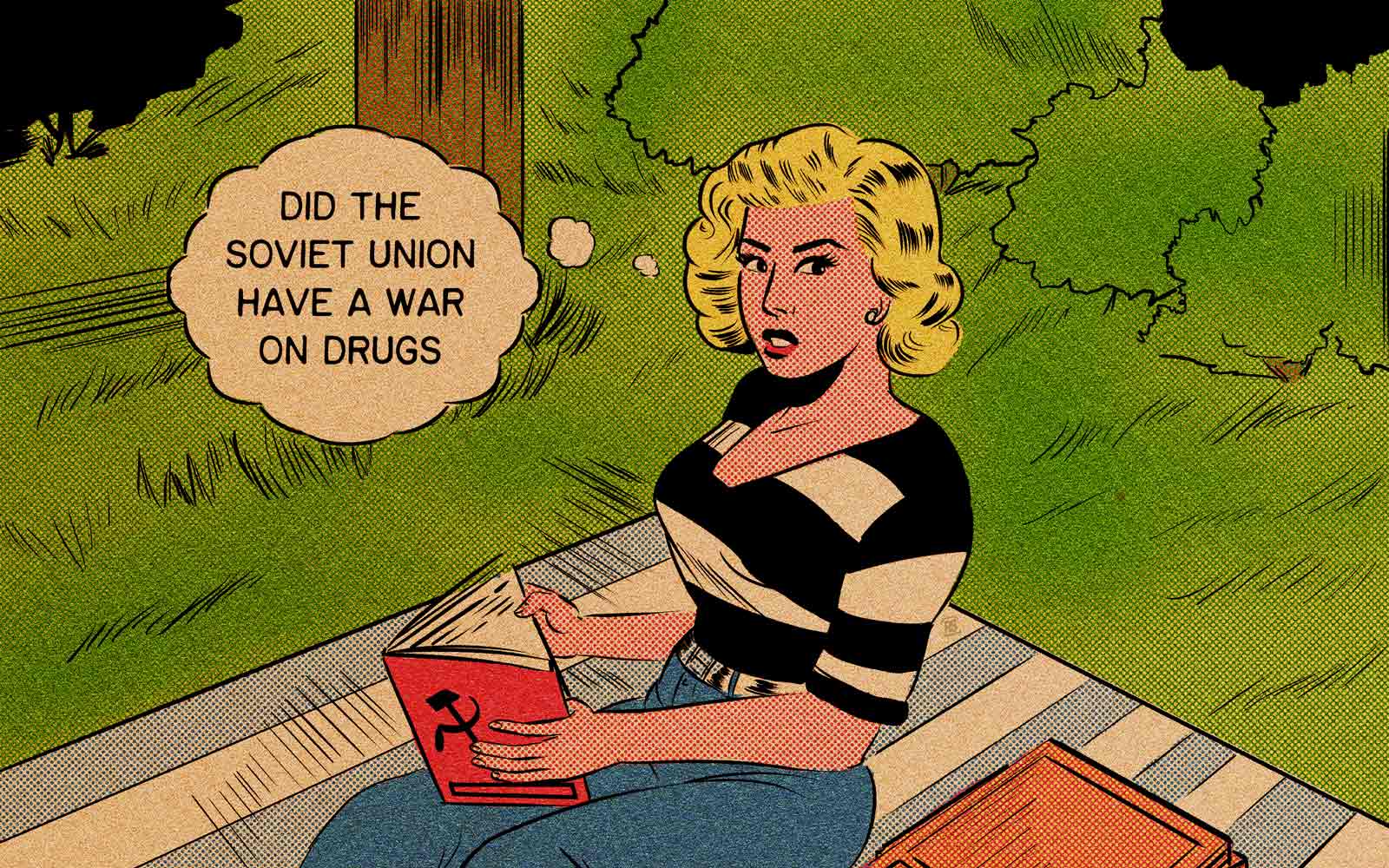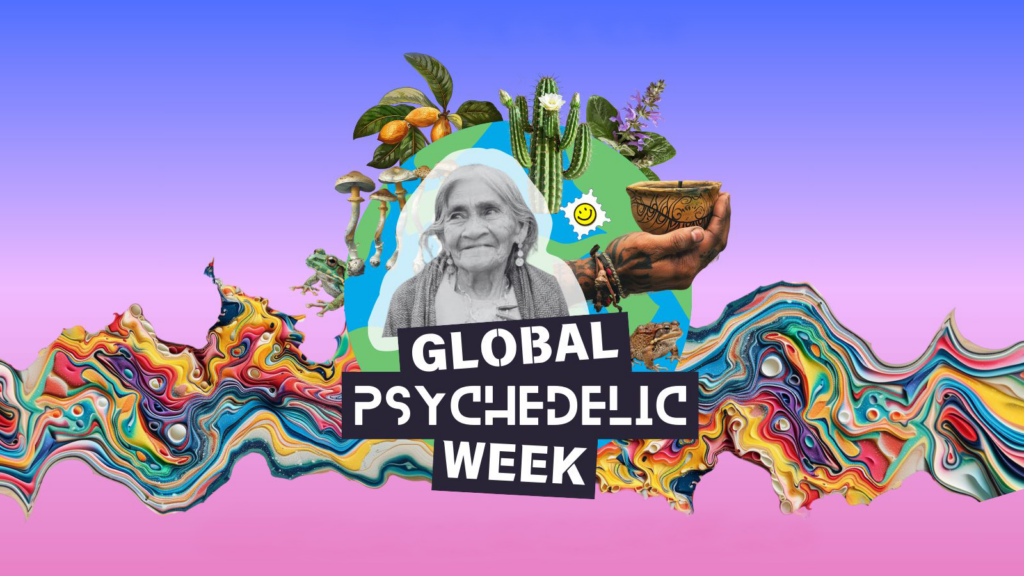Thirty years on from the dissolution of the USSR and its orbital socialist states, the Western world clings tightly as ever to balm Cold War platitudes and beliefs about the drab daily existence forced upon millions of people behind the iron curtain. Though rough-hewn and tightly regimented even by our contemporary standards, was living in the Soviet sphere entirely without a glimmer of counter-cultural expression or psychedelic exploration? Did people in the Warsaw Pact countries ever get high?
Glints in Culture and Media
Life in the Eastern Bloc was a trip. The socio-economic and political ideology underpinning the realities of its inhabitants were worlds apart from our own. While it’s primarily remembered in the West as draconian, monolithic, and unyielding, the portrait that this memory paints is incomplete. Before the USSR’s political and cultural drift toward “socialist realism” in the mid-late 1930s, the Soviet Union’s interwar years were typified by avant-garde flourishes of constructivist and futurist expression that would have made the Bauhaus movement blush.
Though the times quickly changed (and certain styles with them), many features and influences of these artistic modes endured through what we understand as the conversely totalitarian Stalinist era. Readers who might be better familiar with some of the more modern and accessible/popular Soviet works of film, animation, music, and science fiction could probably be persuaded that psychoactive drugs had a hand in shaping many of them. It’s challenging to listen to a Theremin record, watch an Andrei Tarkovsky movie, or read a Strugatsky story without imagining otherwise.
What can reliably be claimed about the history of experimental drug use in the former socialist bloc is, unfortunately, somewhat limited, however. Official records pre-dating the later half of the 20th Century are virtually non-existent, and anecdotal testimony is scarce. Gaining an idea of the proliferation of (and interest in) drugs across such a vast territory requires a deeper dive into the pre-Soviet cultural engagement with the broader subject.
Before Bolshevism
Eastern Europe, and Russia in particular, is far and away most reputed for its love of alcohol (namely vodka, of course). When Vladimir the Great (C.E. 958 – 1015) oversaw Kievan Rus’ transition out of Paganism and into monotheism, he sent emissaries to neighboring lands on a fact-finding mission to help determine which religion he would bid his people adopt. When his envoys returned from an encounter with Bulgarian Muslims and reported that their customs forbade alcohol consumption, he took the Islamic option off of the table, remarking that “drinking is the joy of all Rus’.”
The cultural habitude toward spiritual-form drinking is perhaps most notoriously personified in Grigori Rasputin: the “Madeira monk.” Though Rasputin’s life and legacy are fraught with speculation and myth, — especially insofar as the extent to which he had any control over the Russian monarchy — what we do know for sure about the Siberian peasant turned mysticist adviser to the Romanovs is that he liked to party, and drank insatiably, excusing this behavior on spiritual grounds and getting away with it on the very same basis.
Also native to Siberia is the psychoactive “fly agaric” mushroom. The Amanita muscaria, as it’s also known, represents even earlier cultural importance to the history of Eastern European altered-state-divinity. Ritually used by Northern European and Asiatic shamans, the mushroom is alluded to throughout European folklore and boasts innumerable depictions in Eastern European art and fairytales spanning centuries. Bringing it closer to the current year, the fly agaric has also found absurdist political expression in the semi-infamous “Lenin was a mushroom” 1991 T.V. prank. It has even been floated as a hypothetical explanation for the mysterious Dyatlov Pass incident, which continues to baffle people to this day.
The Iron Curtain and the Black Market
For all of the cultural hay made out of the fly agaric mushroom across the Eastern Bloc, reports of its recreational use during the Soviet era are arrestingly absent. More openly spoken about and more commonly available were marijuana and opiates. Cannabis and opium both, in their own right, have enduring legacies of regionally specific use stretching back to well before the Russian Revolution.
In large parts of what (under Stalin’s rule) became Ukraine, and in even larger areas across the Caucasus and into Central Asia, native marijuana growth was typical. It did not carry the narcotic stigma associated with it by some today. The same was largely true of opium. What’s more, in areas where one or both of them were cultivated or grew naturally and where Islamic influence had taken deeper root (like Central Asia), they were commonly looked upon as fair game alternatives to alcohol and used accordingly.
The creation of the USSR enshrined the unification of these Central Asian hinterlands with the distant territories of Western Russia, and later (with the advent of the Warsaw Pact, Comecon, etc.) connected them with countries even further afield in Europe. As their political institutions, economies, and black markets developed alongside one another, adventurous citizens of the socialist republics as far to the West as Hungary gained greater access to these substances.
However, only a handful of these satellite states on the USSR’s western periphery have published research or conducted tests involving psychedelic drugs. Specifically, experiments involving LSD and psilocybin. The Soviet Union either never conducted or declassified official reports of government programs involving LSD (let alone anything that could hold a candle to the CIA’s “MK-Ultra”). In the 1960s, the socialist republics of Bulgaria, Poland, and Czechoslovakia all used LSD in clinical trials to treat depression, schizophrenia, alcoholism, and other ailments.
Interest in the acid experience quickly reached a fever pitch in Czechoslovakia, with thousands of applicants signing up to participate in trials helmed by the “godfather of LSD,” Stanislav Grof. Among them were artists, writers, and musicians such as Karel Gott and Jiri Anderle. LSD enjoyed enormous popularity in Czechoslovakia (which, at the time, was the world’s largest manufacturer and exporter of the drug) and remained legal in the country until 1974.
Collapse, Shock Therapy, and Flashbacks
By 1979, the year Soviet troops intervened in the conflict engulfing socialist Afghanistan, the USSR was in the depths of an economic glut that was later termed “the era of stagnation.” Involvement in the Afghan civil war altered the aforementioned interrelation of drug culture between Central Asia and the Western Soviet states, permanently and for the worse.
Zbigniew Brzezinski, National Security Advisor to the Carter Administration, famously recognized the Soviet invasion as an “opportunity [to give] the USSR its Vietnam war.” What he saw was a chance to bog Soviet forces down in a demoralizing counter-insurgency, which (like in Vietnam) eventually saw scores of its service members fall to heroin addiction. On the initiative of the CIA-backed mujahideen, opiates flowed more freely than ever across Afghanistan and poured into the USSR from the South.
Meanwhile, back in the Soviet Union, the CPSU had embarked on a fierce campaign to curb excessive drinking in the hopes of regaining some of the USSR’s earlier economic mobility. Begun in the early 1980s during the brief tenure of Yuri Andropov and ended by Mikhail Gorbachev with the Soviet Union’s dissolution, this was probably as close as the USSR ever came to anything like our own “war on drugs.”
While the program was never popular with its citizenry, it did see some initial success in its aim to combat the ills of chronic alcoholism (even moving the needle up on life expectancy for some time). However, it also cost the government billions in lost tax revenue. It led to a massive leap in moonshine production (“samogon” as it’s called in Russia) to make up for the resultant consumer shortages brought on by the state.
The reasons for the USSR’s breakup are too numerous and varied to name all of here, and Eastern Bloc historians still debate which among them are the most telling or essential. The wonder and curiosity that one might have about the uses and effects of drugs, whether psychedelic or otherwise, is much easier to satisfy in the former Soviet territories of today.
Drugs of all sorts have been made more readily available than at any point in the past. The imaginative architectural styles and earlier hallucinatory artforms of the socialist republics may have exited the stage along with the socio-political movements that pushed them forward. Still, they nevertheless survive in memory and remain eternally trippy to new generations of psychonauts.














